




by VASARI, RIDOLFI AND
translated by FRANK
DABELL
and introduced by DAVIDE GASPAROTTO

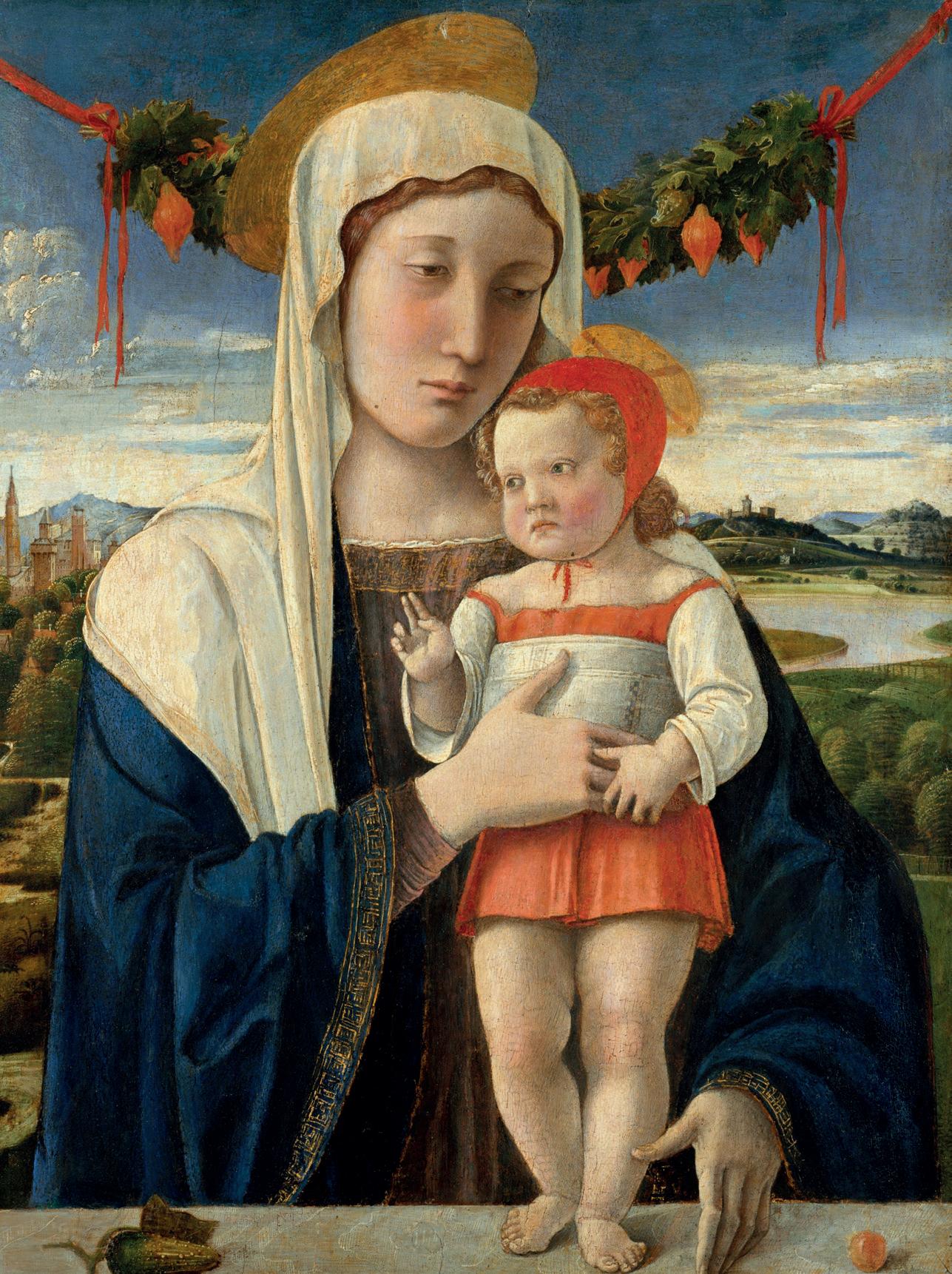
INTRODUCTION by DAVIDE GASPAROTTO
p. 7
LIFE by GIORGIO VASARI
p. 35
LIFE by CARLO RIDOLFI
p. 67
Excerpt from LA CARTA DEL NAVEGAR PITORESCO by MARCO BOSCHINI
p. 101
CORRESPONDENCE WITH ISABELLA D’ESTE
p. 115
List of illustrations
p. 158
Opposite: Virgin and Child (Lehman Madonna), c. 1465-70

davidE gasparotto
On November 29, 1516, the Venetian patrician Marin Sanudo noted the death of Giovanni Bellini (c. 1435–1516) in his diary, observing how his fame was “known throughout the world” and that notwithstanding his advanced age, he was still painting “outstandingly”. Nine years earlier, in February 1507, when Giovanni’s brother, Gentile, had died, Sanudo had written: “There remains his brother Giovanni Bellini, who is the most excellent painter in Italy.” For the thirty-five-year-old Albrecht Dürer, visiting Venice in 1506, Giovanni Bellini had appeared very aged yet still “the best painter of all.” At the opening of the sixteenth century, Giovanni was absolutely unrivalled in his dominant position: he was the official painter of the Republic of Venice, ran the main artistic workshop in the city, and could count the most prestigious names among his clients, even beyond the borders of the Most Serene Republic. Bellini was the recognized master of all genres of painting practiced in Venice during the second half
Opposite: St Jerome, 1505
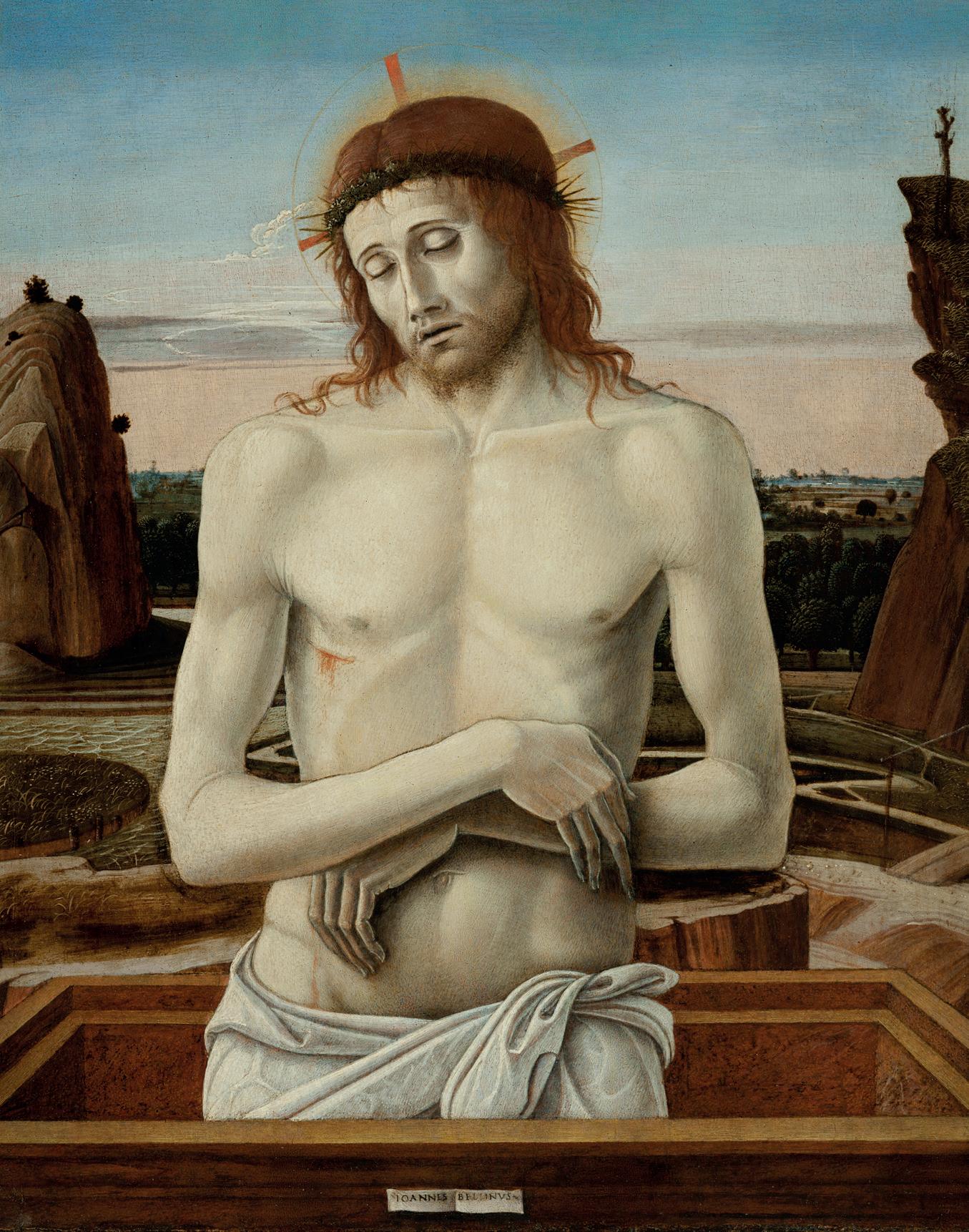

of the fifteenth century: pictures destined for private devotion, narrative cycles, altarpieces, and portraits. Towards the end of his career these traditional categories were augmented with secular allegories and mythological paintings. His role in defining and bringing these genres to maturity was fundamental. His pictures of the Virgin and Child, repeated through infinite variation, the half-length Sacred Conversations, the images of the suffering Christ, and the small panels with repre-sentations of St Jerome in a landscape completely transformed and renewed domestic devotional painting. In the realm of altarpieces, Bellini was the protagonist of a shift from the multipanelled Gothic polyptych to the unified Renaissance pala; his specific contribution was the creation of the Sacred Conversation, a type of painting placed above an altar in which the Virgin, seated on a throne, often within expansive ecclesiastical architecture, is depicted in silent conversation with a group of saints. Even if they are fewer in number, his portraits – which introduce the sitter in three-quarter profile as in Flemish paintings, which enjoyed enormous popularity in Italy at that time – reflect a marked turning
Opposite: Imago Pietatis, c. 1467
Overlaf: Sacred Conversation - Virgin and Child with four saints and a donor, 1507
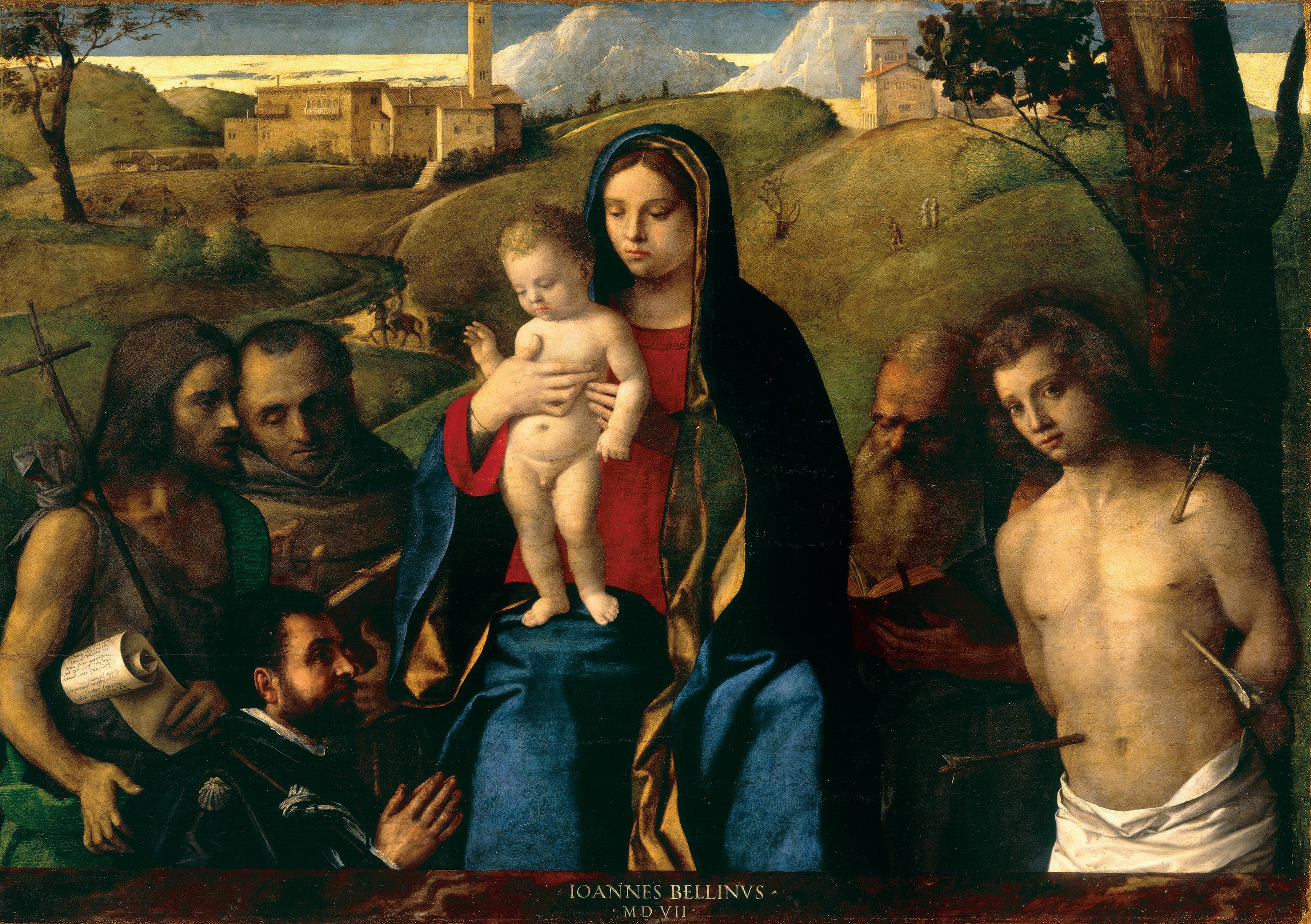

point in the success of the individual portrait in Venice. Our sense of his contribution to the history of narrative painting is more limited because of the irreparable loss of the decorative cycles in the Doge’s Palace in the great fire of 1577. But documents convey Bellini’s continual commitment, almost always alongside his brother, Gentile, to the execution of monumental narrative canvases – both for the different confraternities and for the residence of the doge – which have played such a large part in defining our image of Venetian Renaissance painting. Perhaps only Raphael can equal Bellini in the history of Italian painting for his extraordinary ability to assimilate the styles of other artists, both within Venice and beyond: the rarefied spirituality of Byzantine icons; the lesson of his father, Jacopo; the intense dialogue with the refined all’antica style of his brother-in-law, Andrea Mantegna, and the harsh, expressive sculpture of Donatello in Padua; an attention to the smallest of details and an interest in the description of nature by the Flemish masters, whose work could be admired in so many Venetian homes; the admirable synthesis of perspective and colour in the paintings by Piero della Francesca and Antonello da Messina; and finally, toward the end of his long career, even the subtle atmospheric qualities of Giorgione, young enough to have been his grandson. Bellini combined constant research into expressive innovation
with equally remarkable technical experimentation, playing a leading role in the shift from egg tempera, the very tradition of Italian painting, to oil, inspired by the Flemish model. The move was a gradual one, and occasionally Bellini used both binders on the same painting, allowing him to achieve effects of luminosity and transparency that were absolutely unprecedented. Early sources agree that Giovanni and Gentile Bellini were pupils of their father, Jacopo, the most important and innovative Venetian painter of the first half of the fifteenth century. According to Giorgio Vasari, Giovanni died in 1516 at the age of ninety, so he would have been born in 1426, and therefore the older of the brothers; this is contradicted, however, by several contemporary sources that indicate Gentile was older. Moreover, since Jacopo’s wife, Anna Rinversi, does not mention Giovanni in her will of 1471, it has often been suggested that he was the illegitimate son of Jacopo, born out of wedlock. Giovanni’s date of birth thus remains a matter of debate, with a variety of hypotheses that range from the traditional 1426 to the end of the 1430s. A different birthdate implies a completely different reconstruction of the first years of his career; some scholars see him already emerging during the 1450s, while others maintain that his independent career only started at the beginning of the 1460s. In any case, it is important to remember
two dates: 1459, when Giovanni is documented as living in his own house in the parish of San Lio in Venice, and 1460, when – according to some sixteenth-century sources – together with his father, Jacopo, and brother, Gentile, he signs an altarpiece in the Gattamelata chapel in the basilica of Sant’Antonio in Padua. (The work was subsequently lost, though some scholars have proposed that parts of it can be identified with fragments now housed in various museums.)
Giovanni’s first important independent commission was the St Vincent Ferrer polyptych of the mid-1460s (Venice, Santi Giovanni e Paolo), but it was starting in the 1470s that he must have been truly regarded as the city’s most important painter, dividing his time between the execution of monumental altarpieces and small, exquisite paintings destined for private devotion. Initial and highly significant recognition came in 1479, when his brother, Gentile, left for Constantinople, and Giovanni took his place restoring and renewing the paintings in the Doge’s Palace. His activity received the blessing of the state when he was appointed official painter of the Serenissima on February 26, 1483, which brought with it the privileges of the senseria (a taxexempt broker’s license) at the Fondaco dei Tedeschi and
Opposite: St Vincent Ferrer polyptych, c. 1465

davide gasparotto
exemption from his obligations to the Fraglia, the painters’ guild.
It was certainly in the 1470s that the literati became aware of Giovanni Bellini: in about 1474-75 the Veronese humanist Felice Feliciano already considered him “the most celebrated painter in the world”, while for Raffaele Zovenzoni, a poet from Trieste, Giovanni was “the most distinguished painter”. These are the years in which the artist completed one of his most important works, the altarpiece for the high altar of San Francesco in Pesaro. After this great endeavour his career was well and truly launched, and in comparing the works of the two brothers, more perceptive contemporary observers recognized the undeniable superiority of Giovanni, who was acknowledged from the 1490s not only as the principal painter in Venice but also as one of the greatest living artists in Italy. In the main, literary praise was quite generic, but toward the end of the fifteenth century one also begins to find mentions of specific works: in 1494, for example, the Brescian humanist Bernardino Gadolo recorded the Resurrection, painted for the church of San Michele in Isola and now in the Gemäldegalerie, Berlin, as a “most beautiful panel” (ill. p. 77). Marcantonio Sabellico’s De situ urbis Venetae (1492) and Marin Sanudo’s
Opposite: Pesaro altarpiece (principal section), c. 1472-75


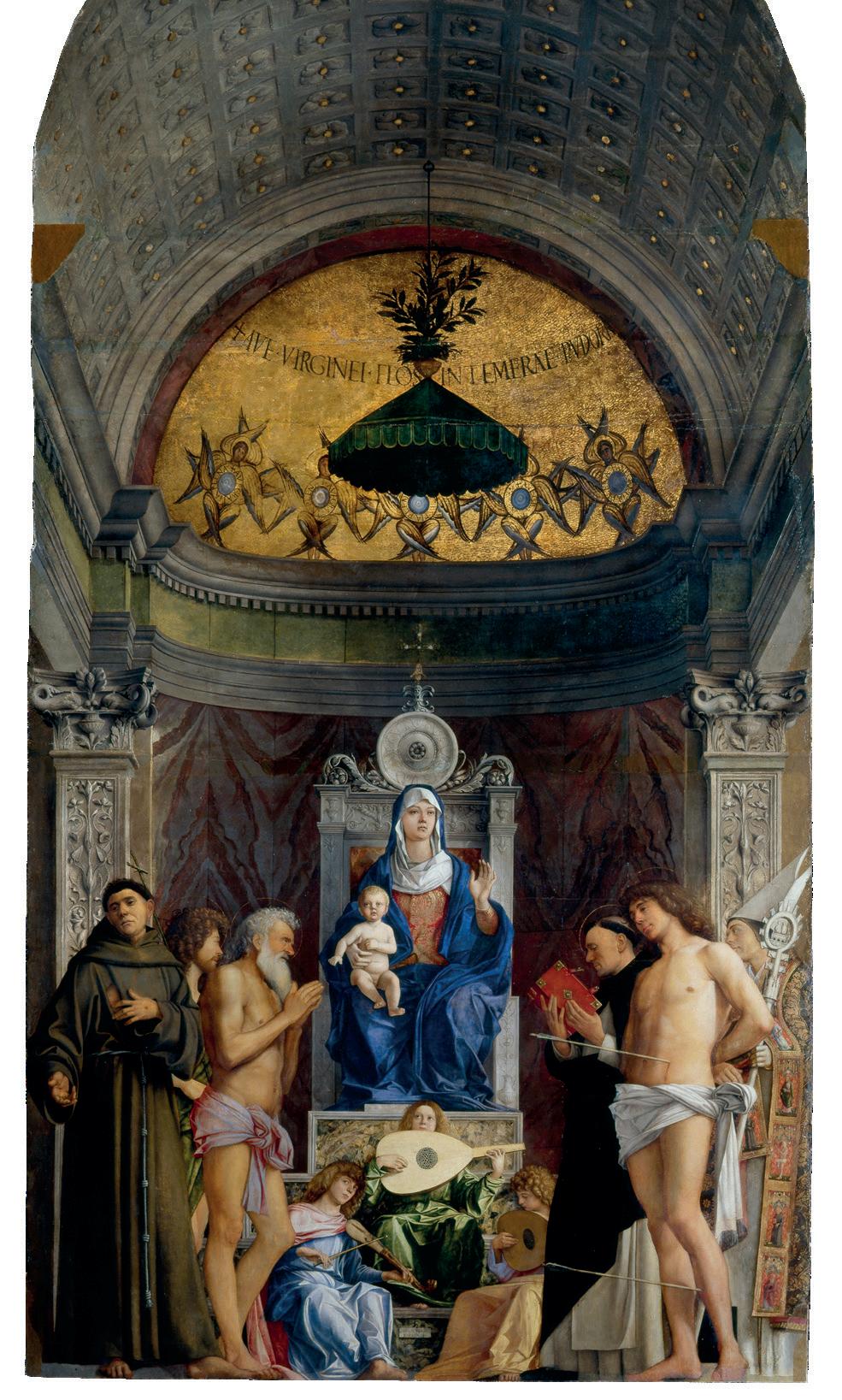
Opposite: San Giobbe altarpiece, c. 1480 introduction
De origine, situ et magistratibus urbis Venetae (1493) both mention the San Giobbe altarpiece of about 1480, one of Giovanni’s major masterpieces. The lost cycle in the Doge’s Palace, for which Sabellico had probably provided the inscriptions, received a large number of literary references, both in prose and poetry. The end of the 1490s and opening years of the new century saw the famous correspondence with the marchioness of Mantua, Isabella d’Este. By this point, Bellini was profoundly conscious of his primacy, allowing himself to deny requests from even the most important patrons. Thus when Isabella asked him to execute a painting for her famous camerino (also known as the studiolo, or little study), diplomatic stalling was followed by definitive refusal. In declining this commission, Bellini doubtless wished to avoid being compared with his brother-in-law, Andrea Mantegna, in an area in which Mantegna excelled and toward which Bellini had no particular inclination: all’antica allegorical painting. He countered Isabella’s request with an offer to paint a Nativity comprising a “work with the infant Christ and Saint John the Baptist and something in the background with other fantasies” – in other words, a sort of Sacred Conversation set in a landscape, a genre in which

Above: The Continence of Scipio, c. 1506. This all’antica frieze was commissioned from Bellini as a companion piece to a painting by Mantegna, who had died before being able to carry it out himself
he was unrivalled. Some scholars have sought to identify this painting, which was delivered in 1504, as the mysterious Sacred Allegory in the Uffizi Gallery, a picture that stands alone within Bellini’s œuvre and might well have been a fitting work for such a demanding and refined patron.
When some time later the marchioness attempted once more to persuade Bellini, through the good offices of the great poet Pietro Bembo, to paint a picture for her studiolo, the painter again turned her down, this time

making an even stronger statement of intolerance with respect to the programme Isabella had asked Bembo to formulate. As Bembo wrote to Isabella on January 11, 1506, “the invention, which you tell me I am to find for his drawing, must be adapted to the fantasy of the painter. He does not like to be given many written details which cramp his style; his way of working, as he says, is always to wander at will in his pictures, so that they can give satisfaction to himself as well as to the beholder.”
Later, at the end of his career, Bellini would yield to
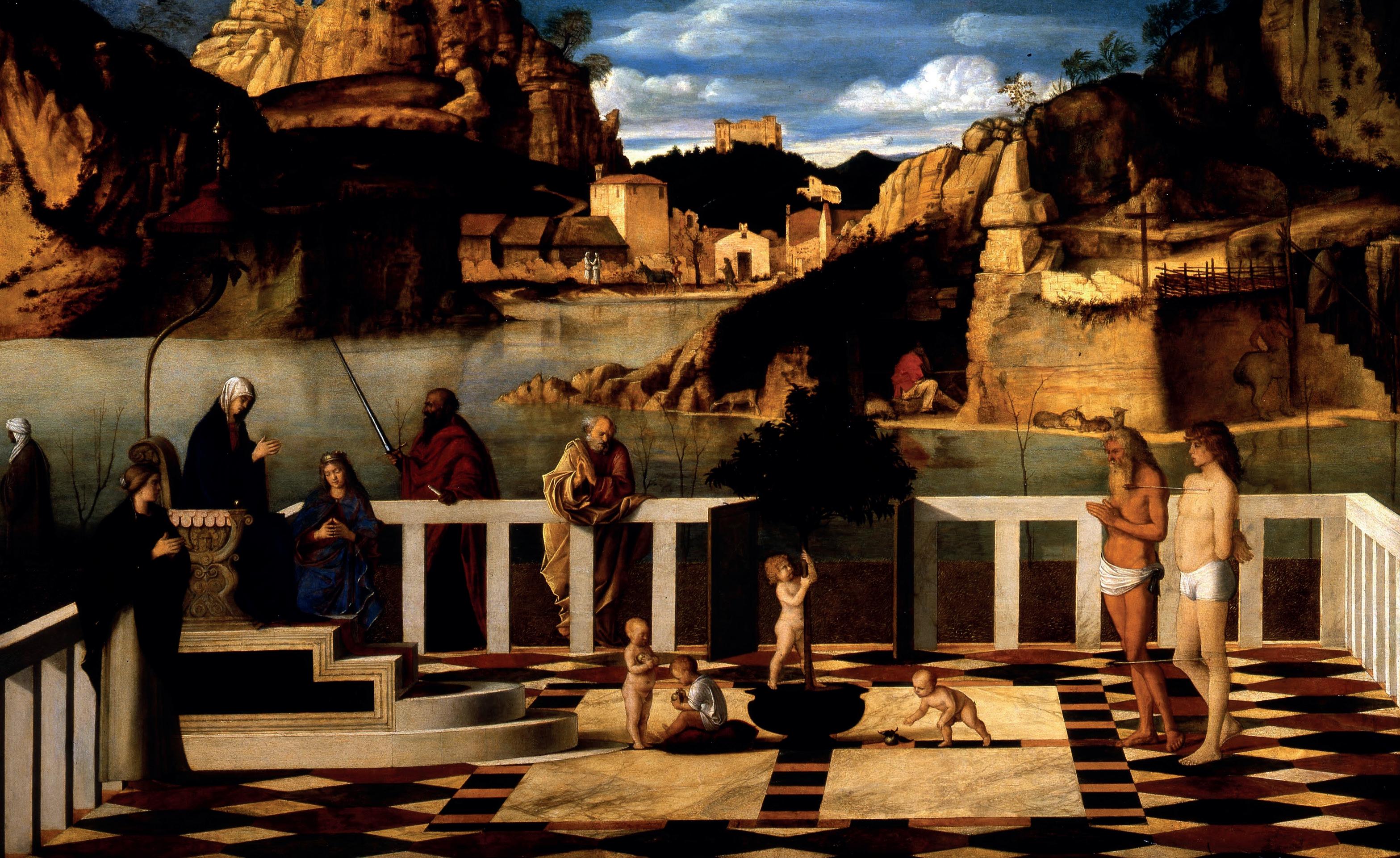

davide gasparotto
the persistent duke of Ferrara, Alfonso d’Este, creating his secular masterpiece The Feast of the Gods (1514), its landscape – as is well known – later reworked by Titian (Washington, National Gallery of Art; ill. p. 99).
After Bellini’s death in 1516, the Venetian aristocrat and art connoisseur Marcantonio Michiel wrote a record of many of the painter’s works that could be admired in both public places – principally churches – and private residences in Venice. Michiel provided the first reference to one of the artist’s absolute masterpieces, the St Francis in the Desert (New York, Frick Collection, ill. p. 28), a painting that was then in the house of Taddeo Contarini, praising especially the “nearby landscape, highly finished and admirably composed”. Michiel himself was very likely the fortunate owner of one of the artist’s late masterpieces, the so-called Donà delle Rose Pietà now in the Accademia in Venice.
Giorgio Vasari could not have known the invaluable notes made by Michiel, which remained in manuscript form until the beginning of the nineteenth century, but he could have met the cultivated Venetian during one of his sojourns in Venice, which provided him with important information for the biographies he was compiling. It was in the 1540s that Vasari (1511-1574), a painter and architect from Arezzo in Tuscany, had started his ambitious project of writing biographies of the major
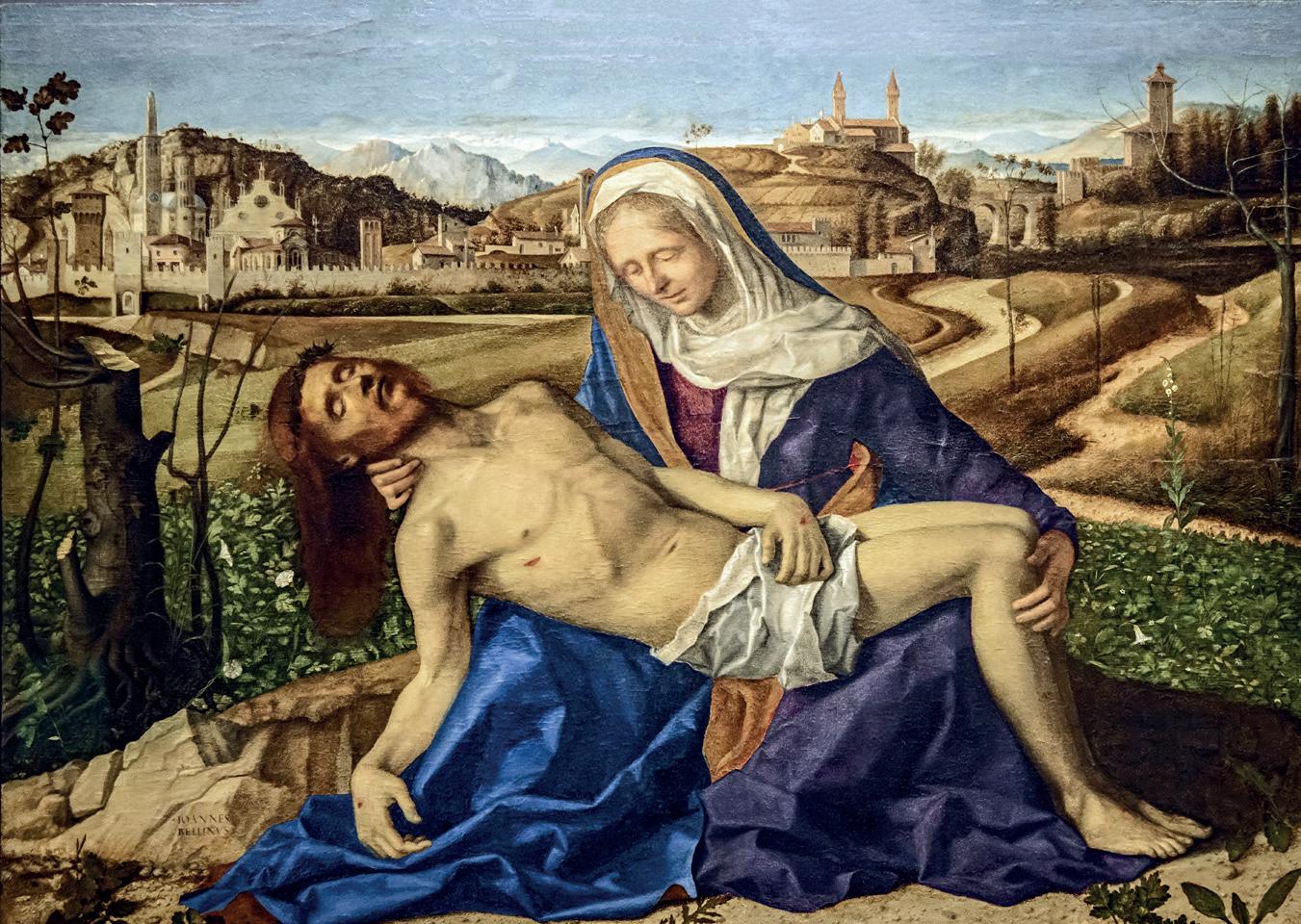

Donà delle Rose Pietà, c. 1495-1500
davide gasparotto
painters, sculptors, and architects from Cimabue to his contemporaries. In 1550 he published the Lives, dedicated to the duke of Florence, Cosimo I de’ Medici, and again a largely revised and augmented edition in 1568. He travelled extensively in Italy in order to collect information and directly inspect works of art. He was in Venice twice, first in 1541 and again in 1566. His Vita di Iacopo, Giovanni e Gentile Bellini Pittori Veniziani, published in the first compilation in 1550 (and then again in 1568 with additions and corrections) is the first complete biography of the three greatest Venetian artists of the Quattrocento. The account is dominated by the description of the large canvases of the Hall of the Great Council in the Doge’s Palace, Bellini’s most important public work, and to this day the text remains one of the most important sources for reconstructing this highly significant pictorial cycle, which was entirely lost during the great fire of 1577. But the Aretine painter and historian mentions many other works by Bellini, including some great altarpieces: one formerly on the altar of St Catherine in the church of Santi Giovanni e Paolo, also sadly destroyed by fire in 1867, as well as the Pala di Pesaro (c. 1473–75) mentioned above, the San Giobbe (c. 1480) and San Zaccaria (1505) altarpieces, and the polyptych in the church of the Frari (1488). Moreover, Vasari did not fail to record the most famous portrait by Bellini,
that of Doge Leonardo Loredan (London, National Gallery, ill. p. 6). The biography closes by quoting a famous sonnet by Bembo in praise of the portrait of a woman the poet loved – probably Maria Savorgnan – painted by Bellini (“O immagine mia, celeste e pura” –“O my image, celestial and pure”), and with the acclaim accorded to Bellini in the famous lines about painters in the 1532 edition of Ludovico Ariosto’s Orlando Furioso, in which the great Venetian painter is listed alongside his brotherin-law, Mantegna, and the younger artists Leo-nardo, Michelangelo, Raphael, Sebastiano del Piombo, Titian, and Dosso and Battista Dossi.
Ariosto’s praise notwithstanding, Vasari believed Bellini’s works were closely tied to an era he must have felt was now irrevocably out of date. Vasari’s reservations are clear, not so much in his account of the lives of the Bellinis, but in the opening to his biography of Pordenone, where he defined Giovanni’s way of painting as “somewhat crude, hard and dry”. These are the same reservations expressed by Ludovico Dolce in his Dialogo di pittura, intitolato l’Aretino (1557); though he judges Bellini to have been a “good and diligent master for his time”, Dolce has Pietro Aretino draw a comparison between the grand manner of Titian, especially in the Assumption of the Virgin in the Frari, and the “dead, cold things by Giovanni Bellini”.

In 1660 the Venetian painter, restorer, engraver and art dealer Marco Boschini (1605-1681) published his La Carta del navegar pitoresco, whose title can be translated as ‘‘The map of pictorial navigation”, a poem in the form of an imaginary dialogue between a dilettante Venetian senator and a professor of painting. The poem is an ardent patriotic and polemical defense of Venetian painting written in Venetian dialect and directed against the Roman and Tuscan norms represented by Vasari. Boschini is not interested in biographical details and he looks at paintings more with an artist’s eye for formal problems and expressive qualities. His characterization of Bellini’s style and his descriptions of the San Giobbe altarpiece and St Francis in the Desert are infused with intense poetic mood. In this way he is able to capture better than any of Bellini’s biographers the profound spiritual tone of the artist’s masterpieces, the subtle harmony of his colouring, and the glorious beauty of his landscapes.
A century after Vasari, Carlo Ridolfi (1594-1658) provided a new biography of Bellini. Ridolfi, a painter of rather modest ambition, did not did not possess Boschini’s critical intelligence; rather, he was a compiler, diligently synthesizing the information given by Vasari. With the help of texts such as Francesco Sansovino’s Venetia città nobilissima et singolare of 58, and with his knowledge
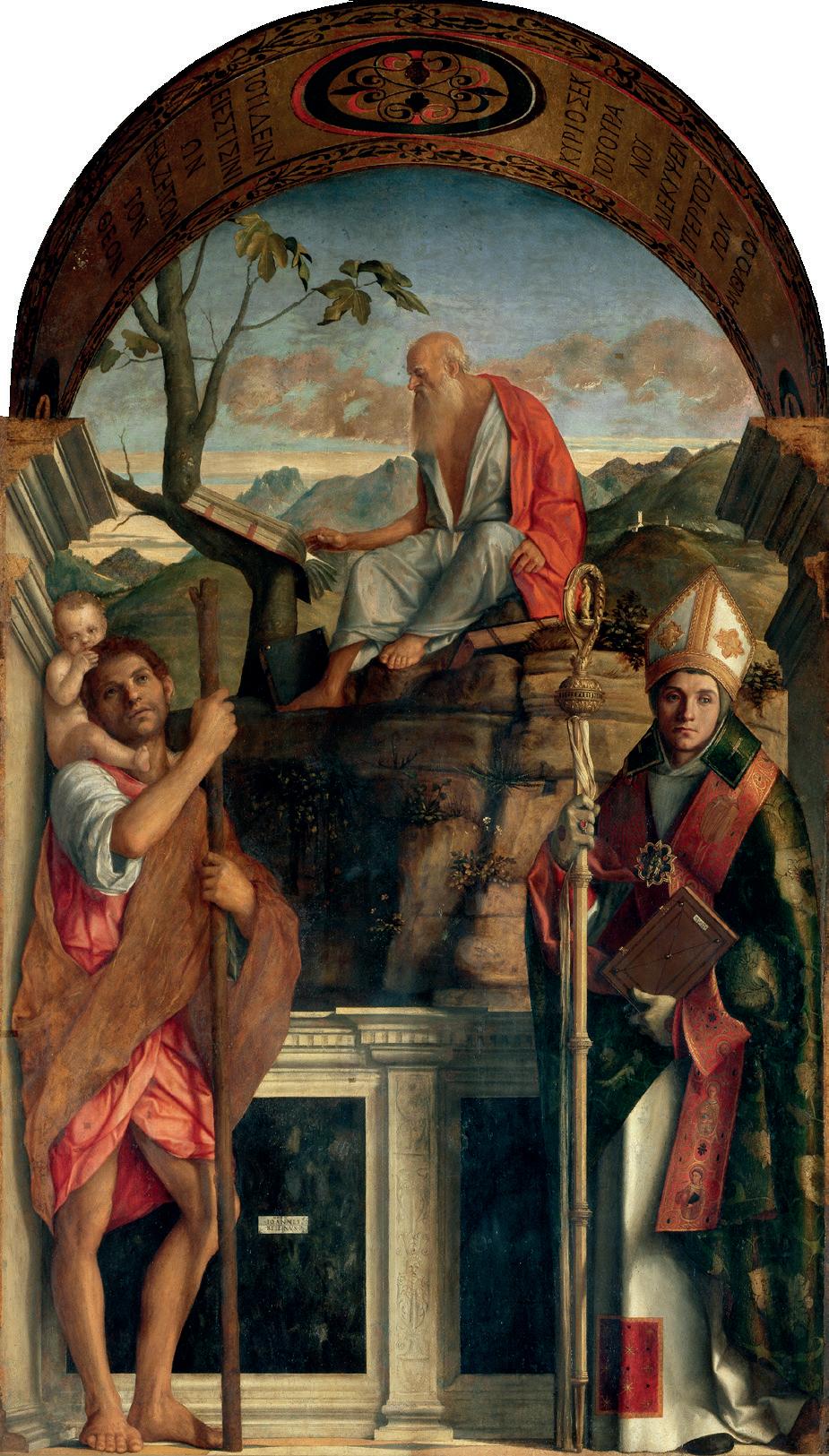
of Venetian private collections, Ridolfi was in a position to expand the number of works in Bellini’s œuvre, providing further information on their patrons and whereabouts. Ridolfi mentions several works not cited in Vasari – both in private hands, such as the Contarini Madonna (Venice, Accademia, ill. p. 73) and Morelli Madonna (Bergamo, Accademia Carrara, ill. p. 91), and on public view, including the Paliotto Barbarigo (Murano, San Pietro Martire, ill. overleaf), the Baptism of Christ (Vicenza, Santa Corona), and Sts Jerome, Christopher and Louis of Toulouse (Venice, San Giovanni Crisostomo), one of the masterpieces of Bellini’s old age. Ridolfi is also the only author to record a portrait of the poet Pietro Bembo, which has been tentatively identified as the extraordinary Portrait of a Young Man (c. 1505) in the British Royal Collection (ill. p. 96).
Subsequent scholars and writers continued to recognize Giovanni Bellini as the patriarch of the Venetian school of painting but considered him above all the teacher of Giorgione, the true originator of modern painting in Venice. During the seventeenth and eighteenth centuries, the great champion of Venetian art was Opposite: Sts Jerome, Christopher and Louis of Toulouse, 1513
Overleaf: T he Paliotto Barbarigo: Virgin and Child with Sts Mark and Augustine, and Doge Agostino Barbarigo, 1488


Titian, with Bellini appearing merely as a timid precursor. It was only beginning in the nineteenth century, with the gradual rediscovery of the “primitives”, or the painters active before Raphael, that the qualities of Bellini’s work – his minute attention to detail, sincerity of religious sentiment, and magnificent passages of landscape – once again attracted the attention of critics and the appreciation of collectors. Thus it came to be that John Ruskin, the most influential art critic of Victorian Britain, lauded the Frari polyptych (1488) and the San Zaccaria altarpiece (1505) as “the two best pictures in the world”.
Jacopo, Giovanni, and Gentile Bellini
of Venice from
1568
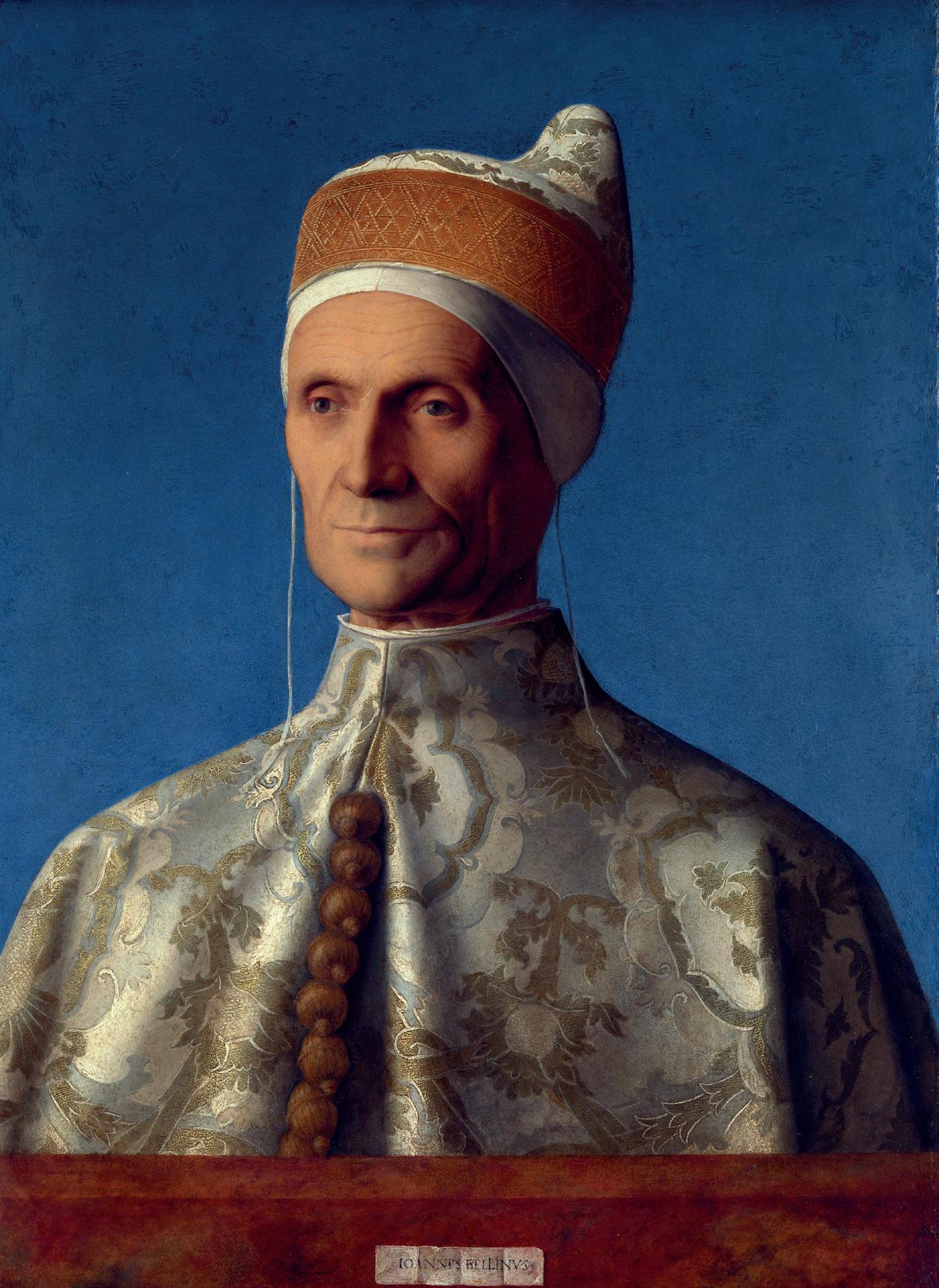
Enterprises that are founded on excellence, although their beginnings often appear humble and mean, keep climbing higher step by step, nor do they ever halt or take rest until they have reached the supreme heights of glory: as could be clearly seen from the poor and humble beginning of the house of the Bellini, and from the rank to which it afterwards rose by means of painting. Jacopo Bellini, a painter of Venice, having been a disciple of Gentile da Fabriano, worked in competition with that Domenico [Domenico Veneziano] who taught the method of colouring in oil to Andrea dal Castagno; but, although he laboured greatly to become excellent in that art, he did not acquire fame therein until after the departure of Domenico from Venice. Then, finding himself in that city without any competitor to equal him, he kept growing in credit and fame, and became so excellent that he was the greatest and most renowned man in his profession. And to the end that the name which he had acquired in painting might not only be maintained in his house and for his descendants, but might grow greater, there were born to him two sons of good and beautiful intelligence, strongly inclined to
Opposite: Doge Leonardo Loredan, 1501-1502